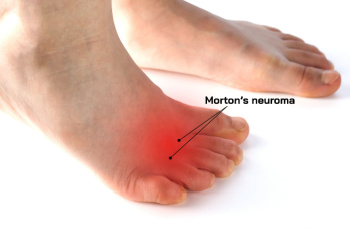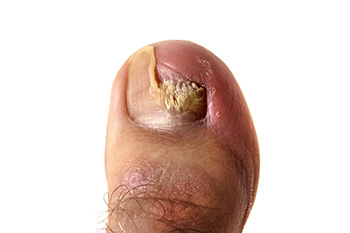Connect With Us
Blog
Items filtered by date: May 2025
Podiatrists and the Conditions They Treat

A podiatrist is a medical professional who specializes in diagnosing and treating conditions related to the feet, ankles, and lower legs. They receive extensive training in foot and ankle care, including both non-surgical and surgical treatment options. Podiatrists treat a wide range of issues such as heel pain, bunions, hammertoes, ingrown toenails, fungal infections, and foot injuries. They also manage complications related to diabetes, including foot ulcers and nerve damage. Podiatrists provide care for individuals of all ages, from children with flat feet to seniors with arthritis or circulation problems. This type of doctor also plays an important role in preventive care by offering guidance on footwear, gait, and foot hygiene. If you have foot or ankle pain, it is suggested that you promptly contact a podiatrist for treatment.
If you are experiencing pain in the feet or ankles, don’t join the stubborn majority refusing treatment. Feel free to contact Wendy L. Grossman, DPM from New Jersey. Our doctor can provide the care you need to keep you pain-free and on your feet.
What Is a Podiatrist?
Someone would seek the care of a podiatrist if they have suffered a foot injury or have common foot ailments such as heal spurs, bunions, arch problems, deformities, ingrown toenails, corns, foot and ankle problems, etc.
Podiatric Treatment
A podiatrist will treat the problematic areas of the feet, ankle or lower leg by prescribing the following:
- Physical therapy
- Drugs
- Orthotic inserts or soles
- Surgery on lower extremity fractures
A common podiatric procedure a podiatrist will use is a scanner or force plate which will allow the podiatrist to know the designs of orthotics. Patients are then told to follow a series of tasks to complete the treatment. The computer will scan the foot a see which areas show weight distribution and pressure points. The podiatrist will read the analysis and then determine which treatment plans are available.
If you have any questions, please feel free to contact our office located in Bloomfield, NJ . We offer the newest diagnostic and treatment technologies for all your foot care needs.
Challenges of Diagnosing Morton's Neuroma

Morton's neuroma is a painful condition involving a thickening of tissue around a nerve in the ball of the foot, often between the third and fourth toes. One of the main challenges in diagnosing it is that the symptoms can mimic other foot problems such as metatarsalgia, stress fractures, or nerve-related issues. People may describe a burning feeling, tingling, or the sense of stepping on a pebble, but the pain may come and go, making it harder to pinpoint. Physical exams and imaging sometimes miss the neuroma, especially in early stages. Patients may go through multiple treatments for the wrong condition before receiving an accurate diagnosis. A thorough evaluation by a podiatrist, including listening closely to symptoms and examining foot structure and pressure points, is essential. If foot pain persists without a clear cause, it is suggested you see a podiatrist for an accurate diagnosis and appropriate treatment.
Morton’s neuroma is a very uncomfortable condition to live with. If you think you have Morton’s neuroma, contact Wendy L. Grossman, DPM of New Jersey. Our doctor will attend to all of your foot care needs and answer any of your related questions.
Morton’s Neuroma
Morton's neuroma is a painful foot condition that commonly affects the areas between the second and third or third and fourth toe, although other areas of the foot are also susceptible. Morton’s neuroma is caused by an inflamed nerve in the foot that is being squeezed and aggravated by surrounding bones.
What Increases the Chances of Having Morton’s Neuroma?
- Ill-fitting high heels or shoes that add pressure to the toe or foot
- Jogging, running or any sport that involves constant impact to the foot
- Flat feet, bunions, and any other foot deformities
Morton’s neuroma is a very treatable condition. Orthotics and shoe inserts can often be used to alleviate the pain on the forefront of the feet. In more severe cases, corticosteroids can also be prescribed. In order to figure out the best treatment for your neuroma, it’s recommended to seek the care of a podiatrist who can diagnose your condition and provide different treatment options.
If you have any questions, please feel free to contact our office located in Bloomfield, NJ . We offer the newest diagnostic and treatment technologies for all your foot care needs.
Causes and Risk Factors of Split Toenails

Split toenails, medically known as onychoschizia, refer to the condition where the toenail becomes brittle and begins to separate or peel. This often occurs when the nail loses moisture and becomes fragile. Common causes include repeated trauma, excessive exposure to water, and harsh chemicals found in nail products. Fungal infections and certain medical conditions can also contribute to weakened nail structure. Aging naturally increases the risk, as the nails tend to dry out and thin over time. Nutritional deficiencies, particularly a lack of vitamin B7 or iron, may make nails more susceptible to splitting. Individuals who frequently wear tight footwear or perform repetitive movements involving their toes may face a higher risk. If your toenails have split, it is suggested that you promptly contact a podiatrist who can determine the cause and offer appropriate treatment solutions.
Toe pain can disrupt your daily activities. If you have any concerns, contact Wendy L. Grossman, DPM of New Jersey. Our doctor can provide the care you need to keep you pain-free and on your feet.
What Causes Toe Pain?
Most severe toe pain is caused due to a sports injury, trauma from dropping something heavy on the toe, or bumping into something rigid. Other problems can develop over time for various reasons.
Toe pain can be caused by one or more ailments. The most common include:
- Trauma
- Sports injury
- Wearing shoes that are too tight
- Arthritis
- Gout
- Corns and calluses
- Hammertoe
- Bunions
- Blisters
- Ingrown toenails
- Sprains
- Fractures (broken bones)
- Dislocations
When to See a Podiatrist
- Severe pain
- Persistent pain that lasts more than a week
- Signs of infection
- Continued swelling
- Pain that prevents walking
Diagnosis
In many cases the cause of toe pain is obvious, but in others, a podiatrist may want to use more advanced methods to determine the problem. These can range from simple visual inspections and sensation tests to X-rays and MRI scans. Prior medical history, family medical history, and any recent physical traumatic events will all be taken into consideration for a proper diagnosis.
Treatment
Treatments for toe pain and injuries vary and may include shoe inserts, padding, taping, medicines, injections, and in some cases, surgery. If you believe that you have broken a toe, please see a podiatrist as soon as possible.
If you have any questions please contact our office located in Bloomfield, NJ . We offer the newest diagnostic and treatment technologies for all your foot and ankle needs.
Get Professional Care for a Broken Foot or Ankle
Understanding and Treating Ingrown Toenails

Ingrown toenails are a common source of discomfort, especially in younger males who often wear tight shoes or play sports that stress the toes. This condition occurs when the edge of the toenail curves and grows into the surrounding skin, causing pain, redness, and sometimes infection. Early treatment often includes soaking the foot, using antiseptics, and gently lifting the nail edge to reduce pressure. When conservative methods do not help, minor in-office procedures can remove part of the nail and prevent it from growing inward again. Surgery is usually quick, with minimal recovery time. Proper nail trimming and wearing well-fitting shoes can reduce the risk of recurrence. If your toe becomes swollen, tender, or shows signs of infection, it is suggested that you see a podiatrist for appropriate treatment.
Ingrown toenails can become painful if they are not treated properly. For more information about ingrown toenails, contact Wendy L. Grossman, DPM of New Jersey. Our doctor can provide the care you need to keep you pain-free and on your feet.
Ingrown Toenails
Ingrown toenails occur when a toenail grows sideways into the bed of the nail, causing pain, swelling, and possibly infection.
Causes
- Bacterial infections
- Improper nail cutting such as cutting it too short or not straight across
- Trauma to the toe, such as stubbing, which causes the nail to grow back irregularly
- Ill-fitting shoes that bunch the toes too close together
- Genetic predisposition
Prevention
Because ingrown toenails are not something found outside of shoe-wearing cultures, going barefoot as often as possible will decrease the likeliness of developing ingrown toenails. Wearing proper fitting shoes and using proper cutting techniques will also help decrease your risk of developing ingrown toenails.
Treatment
Ingrown toenails are a very treatable foot condition. In minor cases, soaking the affected area in salt or antibacterial soaps will not only help with the ingrown nail itself, but also help prevent any infections from occurring. In more severe cases, surgery is an option. In either case, speaking to your podiatrist about this condition will help you get a better understanding of specific treatment options that are right for you.
If you have any questions, please feel free to contact our office located in Bloomfield, NJ . We offer the newest diagnostic and treatment technologies for all your foot care needs.
Blog Archives
- September 2025
- August 2025
- July 2025
- June 2025
- May 2025
- April 2025
- March 2025
- February 2025
- January 2025
- December 2024
- November 2024
- October 2024
- September 2024
- August 2024
- July 2024
- June 2024
- May 2024
- April 2024
- March 2024
- February 2024
- January 2024
- December 2023
- November 2023
- October 2023
- September 2023
- August 2023
- July 2023
- June 2023
- May 2023
- April 2023
- March 2023
- February 2023
- January 2023
- December 2022
- November 2022
- October 2022
- September 2022

